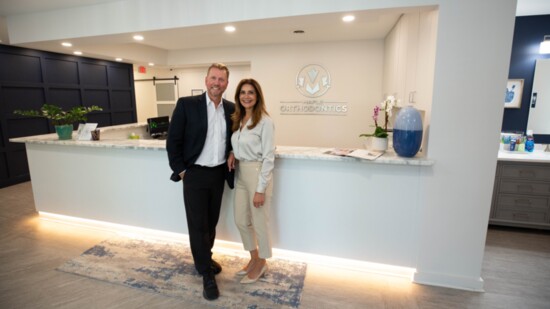“I was the first.”
I’m stunned. Dr. Sindy Goodman has just told me she was the first Chaldean orthodontist in the United States.
“The first woman?” I ask in confusion.
“No. The first person. Ever.”
Sindy's mother, Raja Kinaia, was married off at a young age. She found herself as a single mother with a middle school education, raising four children on her own while working a job in a downtown Detroit supermarket.
“By the time my siblings and I were teenagers,” Sindy explains, “we all worked to just pay bills, just to make it through life. My mom was so resentful that her family married her off at such a young age that she was not going to let that happen to me or my siblings. She said, ‘I want to make sure you can sustain yourselves.”
The trailblazing Sindy and her husband, Dr. Robert Goodman, own Maple Orthodontics in West Bloomfield. The practice offers the latest in high-fashion braces.
“Working with kids lights me up,” says Robert, whose own father is a retired orthodontist. “Orthodontics is like a puzzle. Every person that comes to me has a unique solution.”
Sindy admits that, perhaps because of her educationally-focused upbringing, she has very high standards.
“I’m a Type-A, an overachiever. I don't know how to do mediocre. I'm all about things being perfect. Put healthy teeth in the right position? That matches my personality perfectly. I strive for perfection and orthodontics is about striving for perfection. My patients will settle before I'll settle.”
Robert says the quest for perfection should begin at age seven, according to the American Association of Orthodontists.
“If I see a hundred consultations in that age range, probably only 10 or 20 really need intervention,” Robert notes. “The others, we just bring them back and watch them grow up.”
If they recommend braces, Robert makes sure parents know it’s because the child needs them.
“'I'm being blatantly honest: I’m not motivated to start your kid for any other reason other than their own benefit,'" Robert tells parents. "It's not financially motivated at all. So we take insurance—not every orthodontic practice does. We’re willing to go a little lower with our payment strategy, if that helps them afford the treatment.”
Sindy says wearing braces doesn’t carry the stigma it used to.
“When I first started practicing, kids couldn't wait to get their braces off. These kids don't want their braces to come off. Braces have become trendy.”
Sindy says to today's braces-wearing children, the color of their rubber bands is a form of self-expression.
“Black, hot pink—whatever’s vibrant, that’s what they want. They want the world to see their braces.”
I tell her even my wife has had a dizzying array of colors on her metal adult braces: teal, pink, purple, yellow, green, black, burgundy and lilac. Sindy says nowadays, 25 percent of their patients are adults.
“You’re always looking at somebody's smile and at their eyes. You can’t change the eyes, but you can change the smile. Brackets come in ceramic, which is tooth-colored, as well as gold and rhodium—but still patients are asking for the traditional metal braces, and Invisalign because it doesn't show.”
Picking colors is fun. Wearing the nighttime rubber bands isn’t.
"Sometimes the kids knock my socks off and the adults are the ones we struggle with, believe it or not,” Robert observes.
I ask about Sindy's motivational technique to get children to participate in their orthodontal care.
“Wearing rubber bands is something I can't do for them,” Sindy replies. “I’ll say, “The braces make your teeth straight. That's all braces do. They don't know how to fit your top teeth to your bottom teeth. This won't work unless you participate. And everything you do is going to be for you. For a few months, wear these rubber bands, and you’ll go from good to perfect. You want to settle for good or do you want perfect?”
They’re inspiring words, and perhaps they explain why almost three dozen of Robert and Sindy’s former patients have gone on to dental school. Robert shares their latest one.
“The lady who runs the ice cream shop in Keego Harbor, we were in there getting ice cream the other night and she said, “'Hey Dr. Goodman: one of our daughters just got admitted to dental school, and it was her experience in your office. that opened that pathway for her.'”
“It’s the most amazing feeling for them to tell you, ‘I became a dentist because of you,’” Sindy adds.
“And I'm treating kids of patients that I treated 25 years ago,” Robert continues. "They’re bringing their kids to me. And that's special.”
For more on Maple Orthodontics, visit mapleortho.net
“Black, hot pink—whatever’s vibrant, that’s what they want. They want the world to see their braces.”
